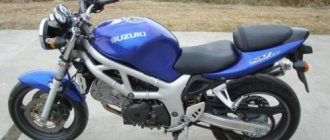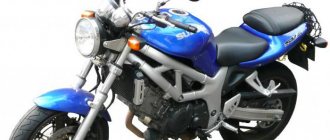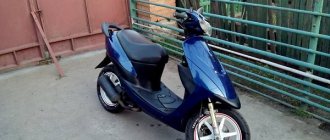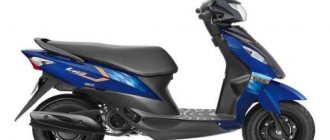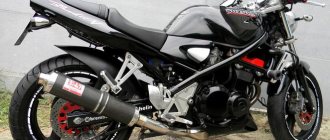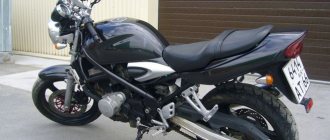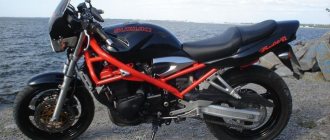Suzuki motorcycle
Suzuki motorcycles are produced by the engineering concern Suzuki Motor Corporation (Japan). The wide model range includes not only all popular classes of motorcycles, but also transitional options between them. All-terrain bikes for off-road conditions and touring modifications for long trips deserve high expert evaluation.
Suzuki open motorcycle (naked) is in high demand. The company produces several modifications. The concern has received worldwide recognition as a manufacturer of high-quality motorcycles with impeccable performance in terms of power, speed and efficiency. The company is a leader in the motorcycle market.
History of the Suzuki brand
The company was born at the beginning of the 20th century. The history of Suzuki dates back to 1909, when a small company under the leadership of Michio Suzuki began producing equipment for weaving factories. By the end of the thirties, the company, following market demands, completed technological preparation for the production of cars. In 1939, the first copies rolled off the assembly line.
The first Suzuki Power Free motorcycle with a 36 cc engine and pedals
During the Second World War, the company suspended operations. The post-war period was marked by advanced design projects. The trial models were the Power Free and Diamond Free motorcycles. The latest model brought glory to the company, winning the championship in the 1953 race.
The model range throughout the 50-60s was represented by low-power motorcycles. The Suzuki X6 modification earned high praise from experts and was in demand on the market. Since 1954, the company has been called Suzuki Motor Co., Ltd.
60cc Suzuki Diamond Free photo
In 1954, the company introduced the first full-fledged Colleda bike with an engine capacity of 90 cm³, which served as the basis for a series of motorcycles with small displacement engines. Two-wheeled Suzukis have become a recognizable brand. The machines were exported to European and American countries. The annual production volume exceeded 70 thousand units.
suzuki colleda photo
In 1967, the company introduced the T500 Cobra modification with a 500 cm³ two-cylinder engine. The bike was equipped with a five-speed transmission and an air engine cooling system. The modification served as a prototype for a number of models.
By the beginning of the seventies, the company prepared to produce a powerful sports motorcycle, the Suzuki GT750. The quality factor and affordable price ensured the model's demand in the market.
Suzuki GT750 photo
1976 marked the release of the Suzuki GS750. The motorcycle reached the top, bringing fame to the GS line. On its basis, the Suzuki GS 1000 was created with improved characteristics. Experts noted the boring design as a drawback. As a result of improvements, the GSX R1000 model was recognized as a favorite in its class. The machine with a lightweight frame of increased rigidity was distinguished by its strength and high traction characteristics at any engine speed. The GSX R1000 was the first model to be customizable to suit the driver's needs.
Suzuki GSX R1000 photo
The beginning of the 90s of the 20th century was the period when the Bandit . The four-cylinder in-line engine with variable valve timing combines low and high gears in the mechanism. The Vandit 400 series bike is equipped with a frame made of steel pipe, providing the strength necessary for a high-speed motorcycle. Lightweight and maneuverable, the Suzuki Vandit 400 has become a standard among bike enthusiasts. Technical indicators and successful marketing allow the model to remain in demand at the beginning of the 21st century.
Suzuki Bandit
GSX sports line is a modification of the Suzuki GSX 1300R. The fast bike can reach speeds of 300 km/h. The company began serial production of the machine in 1999. Engineers are improving the model line, paying attention to sports bikes as the brand’s calling card. The motorcycle catalog tells the story of the concern's success.
Suzuki GSX 1300R photo
Characteristics of Suzuki / Suzuki
Suzuki (Suzuki Motor Co. Ltd.), a Japanese company specializing in the production of subcompact and compact off-road vehicles. The headquarters is located in Hamamatsu. By 2001, a third of the shares belonged to the General Motors concern. The Suzuki company was founded by Michio Suzuki in the small village of Hamamutsu on the coast of Japan in 1920 and was engaged in the production of looms. The project to create a small car was started in 1937, and by 1939 several prototype compact cars were completed. Development of the project was put on hold when the government declared civilian passenger cars to be a "non-essential commodity" and Suzuki ordered a halt to production.
At the end of the war, Suzuki's gaze turned again to the automobile industry. The result was a motorized bicycle called the Power Free. Designed to be inexpensive and easy to build and maintain, the Power Free was equipped with a 36 cu. see two-stroke engine. An unprecedented feature was the Two-sprocket system of the mechanism, which allowed a person to use the pedals to assist the engine, or to disconnect the pedals and move only with the help of the engine.
By 1954, Suzuki was producing 6,000 motorcycles per month and changed the company name to Suzuki Motor Co., Ltd. After the success of the first motorcycles, Suzuki created its first car: the 1955 Suzulight. The car included radical innovations such as front- and all-wheel drive, independent suspension and rack-and-pinion steering. Four decades later, these features became standard on cars around the world.
1967 A new generation of front-wheel drive Fronte-360 models is introduced. The cars were equipped with a 2-cylinder engine producing 30 hp. With.
Late 70s was marked by the appearance of the original all-wheel drive Jimny microcar, equipped with 3-cylinder engines of 539 and 797 cc. see An improved version of the Jimny “SJ410” series was introduced in 1981. The car was exported to many countries over the years.
In 1977, Suzuki began manufacturing motor boat engines. By the 1980s, Suzuki was selling a full line of two-stroke engines, ranging from the modest 2 hp. to a mighty 225 hp. With. Along the way, Suzuki introduced a number of major technological advances: computerized engine control, which ensures optimal engine performance. Suzuki is the first company to offer a three-year limited warranty - the longest ever offered for a marine engine.
The first Alto model was released in 1981. For the European market, the car is equipped with a one-liter 4-cylinder engine producing 54 hp. On request, the car is produced with a five-speed gearbox or a three-speed automatic. Since the fall of 1994, this model has been made in India. To attract consumer demand, the 5-door hatchback is sold at the price of a 3-door hatchback.
Since 1982, the production of a new generation of Fronte/Alto/Cervo microcars with 2-, 3- and 5-door bodies and 3-cylinder engines with a capacity of 29-40 hp has been mastered. With.
In 1983, the Cultus (Swift) passenger car with a liter engine was launched onto the market. Swift models are produced for the European market in Hungary at the Suzuki plant. Swift production has been noticeably reduced and now only 3- and 5-door hatchbacks are produced in the GLS and GC variants with an economical 1.0-liter engine producing 53 hp.
In 1985, Suzuki made its big breakthrough by introducing an automobile line to the United States. Over the course of 30 years, Suzuki built Japan's reputation as a manufacturer of world-famous small cars. Suzuki has released the 4WD Samurai to the American market. Suzuki Samurai were snapped up by hundreds of thousands of Americans who wanted a sporty and practical means of transportation.
In 1988, such a famous Suzuki model as the Escudo (Vitara) appeared, equipped with a 1.6-liter engine producing 95 hp. and all-wheel drive. The Vitara model is distinguished by a variety of names and designs. In the USA the car is known as Geo Tracker, in Japan - as Escudo. The car is available with three- or five-door bodies, with a soft or hard top. A long-wheelbase five-door station wagon, Vitara Long, is also produced, which is equipped with the type of engine at the request of the client.
The 1990s began with the company's name changing to Suzuki Motor Corporation. The model range was updated and expanded: in 1991, production of the small 2-seater Cappuccino began.
In 1993, the appearance of the Wagon R model, the start of production and sales in Egypt, the signing of a contract to open a joint venture in China, and the opening of a plant in Hungary. The following year, 1994, the total number of cars produced in Japan reached 10 million.
In 1995, new models were released - the Baleno subcompact passenger car, the X-90, built on the Vitara chassis, as well as the LOVE electric bicycle. In the USA, sales of the Metro model under the Geo brand began.
1997 - the appearance of the Wagon R Wide (Wagon R+) model - a one-liter subcompact car, sold in quantities of about 250,000 units per year. In Europe, sales of Metro began under the Chevrolet brand.
Presentation of the Gran Vitara model, equipped with 1.6-2.5 liter engines and 107-160 hp. took place in 1997
1998 – Kei and Grand Vitara models (for foreign markets), 1999 – 7-seater Every+. The total number of motorcycles produced by 1999 reached 40 million. Also in 1999, a business agreement was signed with Fuji Heavy Industries.
By 2000, Suzuki had reached the 12th position among automakers in the world with sales of approximately 1.8 million units per year. Having celebrated its 80th anniversary, the company changed its president (Masao Toda became him), founded an educational and cultural foundation, and launched new models on the market - Wagon R Solio and Grand Escudo.
And in 2001, a new model entered the American market - the 7-seater SUV XL-7, the largest Suzuki car in size. In Japan, the Aerio passenger car with a 1.5 liter engine, the Aerio Sedan, the 7-seater Every Landy with a 1.3 liter engine, and the MR Wagon mini-car were presented. The company has stopped using lead in the painting of cars and motorcycles. In addition to automobile products, new motorcycle models were released - the large 1.2-liter GS1200SS, the 400 cc American-style Intruder Classic, the GSX1400 and others. A joint product between Suzuki and General Motors, the Chevrolet Cruze, was announced, and agreements were reached with Kawasaki and Nissan.
2002 – the appearance of the Jimny Sierra model, the Alto Lapin mini-car, and the start of exports of the Chevrolet Cruze.
From a small group of talented engineers developing looms, Suzuki has grown into a global company of nearly 15,000 people who create and distribute products in more than 170 countries.
Website: www.globalsuzuki.com
Representative office in Russia: www.suzuki-motor.ru
Suzuki motorcycle photos
The main direction of the company is bikes of the Sports class in the middle weight category. The car is the best option for traveling around the city and beyond. Suzuki Motor Corporation does not deprive those who want to ride a chrome cruiser without fuss. Fans of the brand are offered both classic models and SUVs.
the prize in the class of cruise cars . The model entered the market in 2006, receiving recognition as the crown of technical excellence and design thought. Photos prove the unusual style inherent in two-wheeled Suzukis.
A prominent representative of naked motorcycles - motorcycles without facing parts - is the Suzuki B-King. The stylish bike has surpassed the best brands in its class in terms of performance.
cruiser Suzuki Intruder M1800 photo
Placing hopes on an
enduro , Japan modernized the Suzuki V-Strom 1000 in the year 2022. Enduro motorcycles are developed for tourist cruises on paved roads or extreme off-road trips.
The Suzuki concern is a leader in the world market in terms of quality and driving characteristics among two-wheeled vehicles of this class. The Suzuki V-Strom 1000XT touring enduro is suitable for those who love traveling through mountainous, vegetated terrain.
enduro Suzuki V-Strom 1000XT photo
The concern is a manufacturer of motorcycles with exceptional power and speed. The Suzuki brand is a trendsetter in technical and style trends in the field of bike design.
Post Views: 6,668
